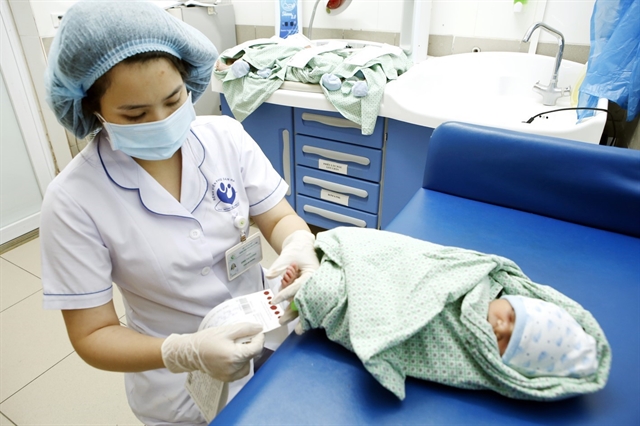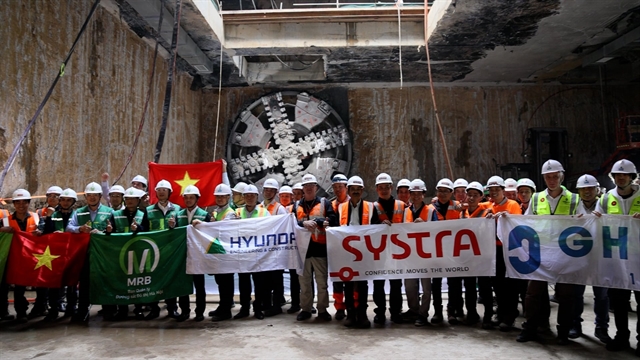 Society
Society

 |
| Neonatal heel prick procedure is conducted on a new-born baby at Hà Nội Obstetrics and Gynaecology. — VNA/VNS Photo Dương Ngọc |
HÀ NỘI — As prenatal and new-born screening can reduce abnormalities by 95 per cent ensuring the health of infants, Việt Nam is focusing on improving screening technology to world standards, dedicated to improving the quality of health in the country’s population.
On average, around 1.5 million babies are born in Việt Nam each year, with about 40,000 suffering from genetic diseases and birth defects.
Prenatal screening allows early detection of many congenital defects and chromosomal abnormalities such as Down syndrome and Thalassemia, a blood disorder passed from parents to children through genes.
Each year, 1,400-1,800 children are born with Down syndrome, while about 2,200 others suffer Thalassemia.
According to Doctor Lê Minh Trác, Director of the Centre for Infant Care and Treatment under the National Hospital of Obstetrics and Gynaecology, prenatal and neonatal malformation screening is extremely necessary for early detection, intervention, and treatment of diseases, abnormities, and metabolic and genetic disorders right in the foetal and neonatal periods.
Early detection and treatment will lead to high treatment efficiency, enabling children to develop completely normally, he said.
Doctor Trác advised pregnant women to get examinations at least three times during their pregnancy and receive screenings that reduce the impact on children.
Data shows that the investment efficiency of new-born screening is 5.7, which means that for every VNĐ1 spent on new-born screening, the society will save VNĐ5.7 in the cost of nurturing and caring for children with disabilities.
For example, the average cost of Thalassemia treatment for a patient with severe Thalassemia from birth to 30 years old is estimated at about VNĐ3 billion (over US$127,000). According to incomplete statistics, Việt Nam currently has about 12 million people carrying the Thalassemia gene and more than 20,000 severe cases requiring lifelong treatment. Every year, the whole country needs more than VNĐ2 trillion for all patients to receive minimum treatment and needs about 500,000 units of blood.
The implementation of pre-marital counselling activities and health check-ups, and prenatal and new-born screening will reduce the society's cost for the treatment of these cases. At the same time, it enables early interventions to minimise malformations from the prenatal period, helping children with normal childbirth and avoid severe physical and mental consequences, thereby reducing the number of people with disabilities in the community, and contributing to improving the quality of health and awareness in the population.
New-born screening
Since 2006, the Ministry of Health has carried out prenatal and new-born screenings, diagnosis, and treatment of some diseases and disorders.
According to Phạm Hồng Quân, Deputy Director of Department of Population Structure and Quality, General Department of Population and Family Planning under the Ministry of Health, the Prime Minister in December 2020 approved a programme on expanding the provision of prenatal and new-born screening, diagnosis, and treatment of some diseases and disorders until 2030.
The programme was carried out nationwide in more than 10,000 districts and communes. District-level health units have performed prenatal screening using ultrasound techniques while commune-level medical stations have carried out neonatal heel prick to take blood samples that are tested for rare genetic conditions.
The ratio of pregnant women that received prenatal tests increased from 20 per cent in 2016 to 56.43 per cent in 2019 while the ratio of new-born babies that underwent screening tests rose from 23 per cent to 40 per cent in the same period.
Quân acknowledged that the implementation of the programme not only brings humanitarian value as it helps to prevent serious consequences in both the mental and physical development of children, but also cuts down social financial burden significantly associated with the cost of future treatments.
However, the programme has run into many difficulties, especially in ethnic minority-dominant and mountainous areas of the country.
A research project on “Exploring barriers to accessing maternal health and family planning services in ethnic minority communities in Việt Nam” – supported by the Ministry of Health, the United Nations Population Fund (UNFPA) in Việt Nam, along with the University of Toronto – showed the ratio of ethnic minority women accessing prenatal services or having prenatal check-ups at least four times during pregnancy (16 per cent) was 58 percentage points lower than the national ratio (74 per cent), revealing new-born screening is neglected in ethnic communities.
Quân said that low level of awareness, especially in ethnic minority areas, about benefits of pre-marital counselling and health examination, prenatal, new-born screening, poor service delivery network in far-flung areas, and insufficient funds have hindered the efficiency of the programme.
The health official believes that although prenatal, new-born screening activities have been implemented nationwide, however, there are many challenges in maintaining and promoting the results of the programme.
Regarding the service network development, Quân said that it is necessary to expand the capability to access quality services among people.
He also suggested more investment into the network while bolstering the types of services provided by public and non-public health facilities based on the needs of each target group and each locality.
The programme on expanding the provision of prenatal and new-born screening, diagnosis, and treatment of some diseases and disorders until 2030 looks to provide premarital health consultancy and check-ups to 90 per cent of couples while reducing the number of consanguineous marriages by 60 per cent.
It aims to have 70 per cent of pregnant women screened for at least four of the most popular congenital diseases and disorders, and 90 per cent of new-born babies screened for at least five of the most common congenital health problems in the next 10 years.
Under this programme, facilities supplying premarital health advice and examinations, as well as prenatal and new-born screening, will be set up in 90 per cent of the commune-level localities nationwide. Prenatal and new-born screening and diagnosis facilities will also be developed at obstetric and paediatric hospitals and general hospitals in 56 provinces and cities.
By 2025, five regional screening and diagnosis centres will be upgraded, and two new similar centres will be built in the northern midland and mountainous region and the Central Highlands.
The programme also expects three prenatal and new-born screening and diagnosis sites at existing medical establishments will reach ASEAN levels in the next five years. — VNS




